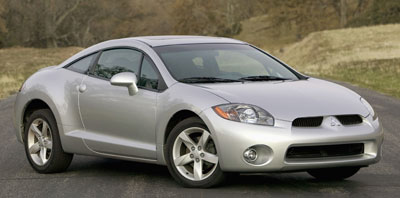|
Welcome to Mitsubish Eclipse

 |
 |
 |
|
|
The Eclipse gets the sport-coupe formula just right. How else can you explain its continued success in the face of so many competitors? It starts with style. The striking look of the Eclipse evolved from our Geo-Mechanical design philosophy.
Under the hood, its spirited acceleration is accompanied by the available race-bred Sportronic® 4-speed automatic transmission with adaptive shift control and clutchless manual shift mode. On top of that, you have more choices – as in a 2.4-liter, 4-cylinder engine (GS), a larger 3.0-liter, V6 engine (GT) or the performance-tuned 3.0-liter, V6 engine with variable induction (GTS). Inside, you find the toy surprise: roomy interior comforts and plenty of conveniences – such as power windows, door locks and mirrors. The Eclipse is the sport coupe that’s ready for your daily commute or your next weekend getaway.
|

Comments: The Mitsubishi Eclipse was all new for 2000, as it shed some of its boy-racer looks and performance, in exchange for more sophistication. Gone were the wild (but unpopular) turbo charged engines and all wheel drive. The Eclipse was now available in three trims, RS, GS, and GT. The RS and GS came standard with a new 2.4 liter Inline four cylinder engine rated at 154 bhp. The GT now sported a 3.0 liter V6 engine rated at 205 bhp. Either engine could be paired up to a five speed manual or four speed automatic transmission. The automatic transmission on the GS and GT models was called Sportronic and included a special gate for shifting on the fly. The Eclipse was larger in every aspect from the previous version, with the wheelbase stretched two inches and the overall length up three inches. Height also increased a few inches. This translated into more interior space. All these improvements added to the bottom line, with the entry level Eclipse increasing in price by about ,000.
Engines: RS,GS: 2.4 I4 154 bhp @ 5500 rpm, 163 lb-ft @ 4000 rpm. GT: 3.0 V6 205 bhp @ 5500 rpm, 205 lb-ft @ 4500 rpm.
Performance: .

Comments: The big news for 1996 was the addition of the all new convertible body style, known as the Spyder. The Spyder was only available in two trims, the Spyder GS with a new normally aspirated 2.4 liter engine or the Spyder GS-T with the turbo charged 2.0 liter engine.
Engines: RS,GS: 2.0 I4 DOHC 140 bhp. GS-T, GSX, GS-T Spyder: 2.0 I4 Turbo 210 bhp @ 6000 rpm, 214 lb-ft @ 3000 rpm. GS Spyder: 2.4 I4 141 bhp.
Performance: GS-T: 0-60 in 6.4 seconds, 1/4 mile in 14.9 seconds @ 91.6 mph.

Comments: For 1992, Mitsubishi Eclipse received minor cosmetic changes. The pop-up headlights were replaced byfixed aerodynamic units while the overall shape of the car was smoothed out to improve aerodynamics.
Engines: Base, GS: 1.8 I4. 2.0 I4 DOHC. GS Turbo, GSX: 2.0 I4 Turbo 195 bhp @ 6000 rpm, 203 lb-ft @ 3000 rpm.
Performance: GS Turbo: 0-60 in 6.8 seconds, 1/4 mile in 15.2 seconds @ 91.5 mph.
xXx_maniak2000@yahoo.com
|
2006 Mitsubishi Eclipse

Comments: 1997 brought more subtle changes to the Eclipse. The most visible change was new high mounted spoilers on both GS_T and GSX models. Also, the front end on all Eclipses received minor changes including projector style fog lamps in a fuller front fascia. The GSX received an upgrade in its wheel/tire package to 17 inch rims and tires, from the 16 inchers its had previously.
Engines: RS,GS: 2.0 I4 DOHC 140 bhp. GS-T, GSX, GS-T Spyder: 2.0 I4 Turbo 210 bhp @ 6000 rpm, 214 lb-ft @ 3000 rpm. GS Spyder: 2.4 I4 141 bhp.
Performance: GS-T: 0-60 in 6.4 seconds, 1/4 mile in 14.9 seconds @ 91.6 mph.
http://www.mitsubishicars.com |
